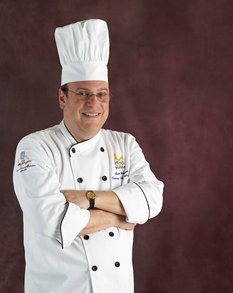50-Minute Classroom: Do You Teach Recipes or Technique?
07 January 2013
 Chef Weiner argues there’s only one right answer.
Chef Weiner argues there’s only one right answer.
By Adam Weiner, CFSE
Paper or plastic? Shaken or stirred? Regular or decaf? Red or white? Recipes or technique? These are some of the great questions that plague culinary instructors on a daily basis. To start the New Year, I am going to open the debate (please post a comment on this website so we can really get the debate going) on whether we should focus our students on learning how to follow recipes or how to use their technical skills to create or duplicate dishes.
Recipes or technique is a question that drives culinary instructors crazy. When I focus on teaching recipes, a number of my friends (many of whom volunteer to teach the class and others who hire my students) tell me that I am doing a disservice, because when they go out into the real world there won’t be recipes. These chefs contend that when the students go out into restaurants they will be shown a dish once and then be expected to duplicate it.
Many other friends (who also volunteer to teach the class and who hire my students) demand that students have to be able to follow recipes, not only to bake, but also to be able to turn out consistent products. Consistency, these chefs contend, is key to making sure that the food always tastes the same, and always has the same ingredients in the same quantities so the chef knows the food costs of each plate. (Imagine what the major chains from McDonald’s to Ruth’s Chris would be like if every cook did things just a little bit differently.)
The two groups feud like the Hatfields and the McCoys. I feel that both groups are not only both right, but also both wrong. In other words, I contend that we must teach our students both recipes and techniques. My proof is basically simple:
1. You cannot follow a recipe if you don’t know basic techniques. If the recipe says “poach,” “braise,” “sauté,” “julienne,” “chiffonade,” etc., then the young cook needs to know how to do these techniques.
2. If the chef at a university dining hall or in a large corporate dining room tells your graduate, “Here is a recipe, make 1,000 pounds of beef stew,” the student had better be able to follow the recipe. Can you imagine trying to eyeball the correct amount of salt for 1,000 pounds of beef stew using just technique?
3. Measuring a quarter teaspoon of salt to add to each pan of a fettuccine dish cooked à la minute at an Italian café would bring the line to a screeching halt. Making 20 lemon-meringue pies using only technique would probably be the death of a young pastry chef. Not knowing how to sweat onions without looking up how to do it would be a major delay in the kitchen and a major embarrassment to the cook.
The question becomes: How to teach both? It isn’t as easy as it seems, because students tend to gravitate to whichever way they like best while ignoring the other. Here is what I recommend:
1. Teach basic knife skills and basic knife cuts first.
2. Teach what basic terms (such as sauté, simmer, dice, etc.) mean through hands-on work. I have already written articles on such things as braising (September 2010), baking (July 2011) and sautéing (January 2012). (Note that the sauté article appears below my article on chocolate dipping in last January’s edition of GMC.) In the upcoming year I will write more articles on how to teach specific techniques.
3. Teach your students how to read and write recipes. My article next month will be on how to do just that.
4. Mix it up.
- Give a specific technique assignment, such as “Prepare ½ pound of poached fish” or “Grill a quarter-pound burger,” etc.
- Give out ingredients and tell the students that they need to be creative, and to prepare several dishes without going online or using a cookbook.
- Give the students a recipe and tell them to follow it.
- Give the students several ingredients and tell them that they must find online or in cookbooks a recipe for those ingredients. Along with the finished product, make the students present the recipe.
Finally, there will soon come a time for every young cook when she or he doesn’t have the exact ingredients available for the recipe. At this time, she or he needs to know not only technique, but have a strong working knowledge of product substitutions.
For example, I have had students try to substitute coconut milk when we ran out of milk. On the other side of the spectrum, I have had students run to me in tears with “Chef, we are out of yellow bell peppers” when I know there was 5 pounds of red bells in the walk-in. (By the way, this is not only an issue for students. I recently taught a one-day seminar for 50 culinary-arts instructors. Most of them panicked in making a soba-noodle salad when I didn’t have baby bok choy available, but did have napa cabbage.)
I teach the necessary skill of learning how to adapt by giving them recipes and advising them that we don’t have all of the specific ingredients. I tell them that they have to work it out themselves and that they can’t ask me or my assistant instructor. This is a great way for them to practice the combination of following a recipe, understanding technique and knowing their ingredients.
Chef Adam Weiner, CFSE, teaches a 20-week Introduction to Cooking program for JobTrain on the San Francisco Peninsula.
